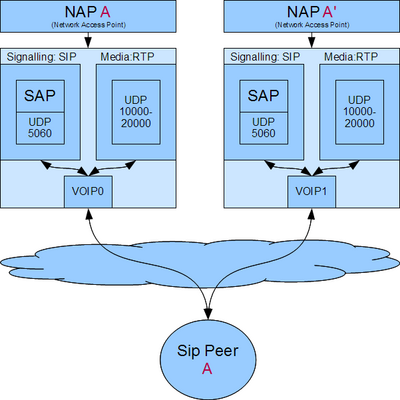Voip Redundancy
From TBwiki
(Difference between revisions)
| Line 7: | Line 7: | ||
== Signaling Redundancy == | == Signaling Redundancy == | ||
| − | In the above example, we have configured two [[NAP]] Network Access Point that reaches the same SIP destination. In the event the ethernet interface VOIP0 went down, the <u>'''''NAP A''''' | + | In the above example, we have configured two [[NAP]] Network Access Point that reaches the same SIP destination. In the event the ethernet interface VOIP0 went down, the <u>'''''NAP A'''''</u would become unavailable, and thus routing would take place using '''<u>''NAP A''''''</u<u></u>''.'' |
| − | + | ||
| + | <br> | ||
== Media Redundancy == | == Media Redundancy == | ||
The [[NAP]] is also associated to the media by assigning an UDP port range for the RTP. When [[NAP]] is unavailable at the signaling level, the assigned RTP ports aren't being used. In the above example, if the <u>'''''NAP A'''''</u> then all new outgoing calls will be using VOIP1 ethernet interface. | The [[NAP]] is also associated to the media by assigning an UDP port range for the RTP. When [[NAP]] is unavailable at the signaling level, the assigned RTP ports aren't being used. In the above example, if the <u>'''''NAP A'''''</u> then all new outgoing calls will be using VOIP1 ethernet interface. | ||
Revision as of 15:08, 20 July 2010
Redundancy of both RTP and SIP can be achieved by configuring one NAP per VoIP interface for a specific remote proxy.
Signaling Redundancy
In the above example, we have configured two NAP Network Access Point that reaches the same SIP destination. In the event the ethernet interface VOIP0 went down, the NAP A</u would become unavailable, and thus routing would take place using <u>NAP A'</u<u>.
Media Redundancy
The NAP is also associated to the media by assigning an UDP port range for the RTP. When NAP is unavailable at the signaling level, the assigned RTP ports aren't being used. In the above example, if the NAP A then all new outgoing calls will be using VOIP1 ethernet interface.
